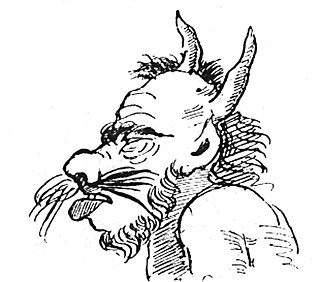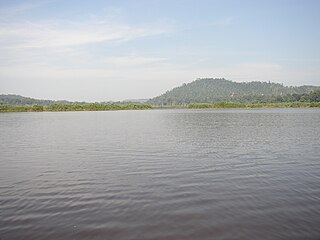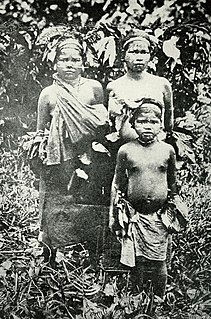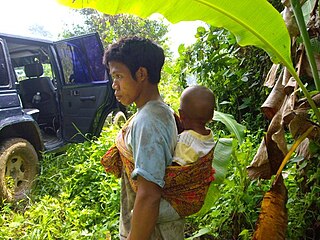
Bies or bes is an evil spirit or demon in Slavic mythology. Under the influence of Christianity the word often became synonymous with chort.

The Semang are an ethnic-minority group of the Malay Peninsula. They live in mountainous and isolated forest regions of Perak, Pahang, Kelantan and Kedah of Malaysia and the southern provinces of Thailand.

Orang Asli are a heterogeneous indigenous population forming a national minority in Malaysia. They are the oldest inhabitants of Peninsular Malaysia.

Jakun people or Orang Ulu / Orang Hulu are an ethnic group recognised as Orang Asli of the Malay Peninsula in Malaysia.

Chini Lake, better known locally as Tasik Chini, is a lake in Pekan District, Pahang, Malaysia. The lake shores are inhabited by the Jakun branch of the Orang Asli.

Temerloh is a municipality in central Pahang, Malaysia. Temerloh has been proved to be the "centre of Peninsular Malaysia" 3TS, which is situated at Kampung Paya Siput, Lanchang. Located about 130 kilometres (81 mi) from Kuala Lumpur along the Kuantan–Kuala Lumpur trunk road, Temerloh is the second largest town in Pahang after Kuantan, the state capital. It is situated at the junction of the Pahang River and the Semantan River. Today, Temerloh usually refers to the territory under the administration of Temerloh Municipal Council which includes Mentakab, Lanchang, Kuala Krau and Kerdau.

The Semai are a semi-sedentary ethnic group living in the center of the Malay Peninsula in Southeast Asia, known especially for their nonviolence. They speak Semai, an Austroasiatic language closely related to Temiar, spoken by Temiars nearby. The Semai are bordered by the Temiars to the north and the Jah Hut to the South. The Semai belong to the Senoi group, and are one of the largest indigenous ethnic group in the Peninsula and the largest of the Senoi group. Most Semai subsist by cultivating grain crops, hunting, and fishing.

The Batek people are an indigenous Orang Asli people ; belonging to the Semang group, who live in the rainforest of peninsular Malaysia. As a result of encroachment, they now primarily inhabit the Taman Negara National Park. The Batek are nomadic hunters and gatherers, so the exact location of their settlements change within the general confines of the area that they inhabit.

The Mah Meri are an ethnic group native to western part of Peninsular Malaysia. They are one of the 18 Orang Asli groups named by the Malaysian government. They are of the Senoi subgroup. Most of the members of the Mah Meri tribe live along the coast of South Selangor from Sungai Pelek up to Pulau Carey, although there is at least one Mah Meri Community on the other side of the Klang River.

The Temuan people are a Proto-Malay ethnic group indigenous to western parts of Peninsular Malaysia. They can be found in the states of Selangor, Pahang, Johor, Negeri Sembilan and Malacca. The Temuans are classified as part of Orang Asli group according to the Malaysian government. They are also one of the largest and the most widespread of the Orang Asli ethnic groups.

The Senoi are a group of Malaysian peoples classified among the Orang Asli, the indigenous peoples of Peninsular Malaysia. They are the most numerous of the Orang Asli and widely distributed across the peninsula. The Senois speak various branches of Aslian languages, which in turn form a branch of Austroasiatic languages. Many of them are also bilingual in the national language, the Malaysian language.

The Temiar are a Senoic group indigenous to the Malay peninsula and one of the largest of the eighteen Orang Asli groups of Malaysia. They reside mainly within Perak, Pahang and Kelantan states. The total ethnic population is estimated at around 32,000, most of which live on the fringes of the rainforest, while a small number have been urbanised.
Orang Kanaq are one of the 18 Orang Asli ethnic groups in Malaysia. They are classified under the Proto-Malay people group, which forms the three major people group of the Orang Asli. The Orang Kanaq are considered as the smallest Orang Asli group with the population of approximately 90 people only.

Jah Hut is an Austroasiatic language spoken around the Krau river in peninsular Malaysia. The Jah Hut are one of the indigenous Orang Asli peoples.

Orang Seletar are one of the 18 Orang Asli ethnic groups in Malaysia. They are classified under the Proto-Malay people group, which forms the three major people group of the Orang Asli. The Orang Seletar are also considered as part of the Orang Laut, natives of the Straits of Johor; separating Singapore from Peninsula Malaysia.

Semelai people are an Orang Asli people of the Proto-Malay people group found in Negeri Sembilan and Pahang states of Malaysia.
Temoq people belong to the Proto-Malay of the Orang Asli ethnic group that are found in Pahang, Malaysia.

Cheq Wong people are an indigenous Orang Asli people of the Senoi branch in Peninsular Malaysia. Although they have the physical appearance of the Senoi sub-group, the Cheq Wong language that they speak is closely related to the Northern Aslian languages.

Jerantut is a town in Pahang, Malaysia. It is located about 200 km from Kuala Lumpur and 180 km from Kuantan. It is located in Jerantut District, which is the largest district in the State of Pahang. It covers an area of 2,900 square miles. Bordered by the States of Kelantan and Terengganu in the North, Temerloh and Maran districts in the South, Kuala Lipis and Raub districts in the West and Kuantan district and Terengganu state in the East. It has 10 mukims consisting of 295 villages administered under 58 JKKK. Jerantut District Council was gazetted on 18 February 1982.

Traditional Malaysian art is primarily composed of Malay art and Bornean art, is very similar with the other styles from Southeast Asia, such as Bruneian, Indonesian and Singaporean. Art has a long tradition in Malaysia, with Malay art that dating back to the Malay sultanates, has always been influenced by Chinese, Indian and Islamic arts, and also present, due to large population of Chinese and Indian in today's Malaysian demographics.



















